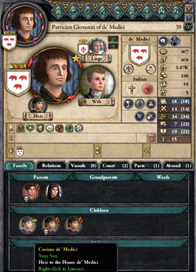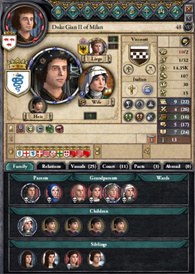In case you missed the first Dev Diary, here it is.
___________________________________________________
As mentioned in last week’s dev diary, Northern Italy served as the birthplace of the Renaissance, for a variety of reasons, including the incredible wealth of the Republican Elites, the remains of Roman influence in Italia and Byzantine scholars fleeing from the crumbling Empire, to name a few. As such, this region is home to many interesting characters whose actions may determine the future of all of Europe.

The Medici Family
Of course, we can’t talk about interesting characters in Northern Italy without mentioning the Medici family. By 1400, the Medici were well on their way up in Florentine society, headed by Giovanni de’ Medici, with some very impressive stewardship. The Medici are poised to become much more powerful in the next few decades, and, with careful guidance, will be able to establish dominance over the Florentine Republic.

However, Florence (Firenze) is surrounded by powerful neighbours, and the future is far from certain.
Duke Gian II of Milan
Duke Gian is the de facto the most powerful character in Northern Italy by 1400. He had recently been elevated from Lord of Milan to Duke in 1395 by the Holy Roman Emperor, but his quest for power was far from over. Beyond his vast core of holdings in Milan, many small Italian states have submitted to Gian’s direct rule and protection, making him a serious threat to his surroundings. As Duke of Milan, there are several paths available to you: you may choose to further your dominance of Northern Italy, decisively bringing it under your yoke and crushing the independent spirit of the Italian city states. Alternatively, you may use your power to dominate political life in the Holy Roman Empire as one of the most powerful vassals; while Patricians count their coins, you can count vassals.

The Renaissance
Having mentioned a couple of significant characters, it is high time we talk about the Renaissance itself. While none of this is yet concrete, I will try to provide a good explanation as to how it will work. A future dev diary (or maybe several) will be dedicated to the Renaissance alone, but it should be mentioned here, given that we’re talking about Northern Italy. Initially, only Florence will be a part of the Renaissance. This will most likely be represented by a modifier applied either to a character (in this case it would be Maso Albizzi, Gonfaloniere of the Florentine Republic) or to the title itself, the Republic of Firenze. However, the Renaissance can rapidly spread, which may happen through events or decisions (or both) throughout Italy. This will in turn unlock a whole host of options and events, which will allow you to use the Renaissance to enhance your personal prestige and piety (through patronage of the arts, for example) and explore different ideas from the Classics. Due to the Roman heritage of Italy, Italians will be able to use Roman ideas to legitimise various forms of government. For example, Republics like Florence, Venice and Ancona will be able to focus on the Roman Republic, adopting more Roman customs from that era. Perhaps, after you have adopted enough Roman customs, your Republic could be considered a successor to that of the Romans?
I’m sorry that this is more speculative than concrete, but I thought it was necessary to provide an idea of what the Italian Renaissance will look like, even if we haven’t started on it yet.
Studio Ghibelline
Conflicts between the Holy Roman Emperor and the Papacy over the control of Northern Italy were certainly nothing new, and the two factions of the Guelphs (Pro-Papacy) and Ghibellines (Pro-Emperor) made the distinction between the two sides all the clearer. Although the conflicts between the two factions began well before our start date, we felt it would be important to address this issue by making the Guelphs and Ghibellines official. Northern Italian rulers will be able to choose to be a part of a faction (by decision), which will grant them a trait- Guelph or Ghibelline. These traits give you an opinion bonus with the Pope or Emperor, and give you access to a new range of casus belli (e.g. to seize land for the Pope if it’s in the hands of a Ghibelline, or to depose a Ghibelline ruler). Of course, being Italians, switching sides is never off the table. The fate of Northern Italy is uncertain…
That concludes this week’s Dev Diary! As ever, if you are interested in helping out, we are looking for more modders to work on the history modding. This could be your chance to shape history! Next week, we’ll take a look at the Balkans.
Here are all of the dev diaries so far:
Dev Diary #000
Dev Diary #1
Dev Diary #2
Dev Diary #3
Dev Diary #4
Dev Diary #5
Dev Diary #6
Dev Diary #7
Dev Diary #8
___________________________________________________
As mentioned in last week’s dev diary, Northern Italy served as the birthplace of the Renaissance, for a variety of reasons, including the incredible wealth of the Republican Elites, the remains of Roman influence in Italia and Byzantine scholars fleeing from the crumbling Empire, to name a few. As such, this region is home to many interesting characters whose actions may determine the future of all of Europe.

The Medici Family
Of course, we can’t talk about interesting characters in Northern Italy without mentioning the Medici family. By 1400, the Medici were well on their way up in Florentine society, headed by Giovanni de’ Medici, with some very impressive stewardship. The Medici are poised to become much more powerful in the next few decades, and, with careful guidance, will be able to establish dominance over the Florentine Republic.

However, Florence (Firenze) is surrounded by powerful neighbours, and the future is far from certain.
Duke Gian II of Milan
Duke Gian is the de facto the most powerful character in Northern Italy by 1400. He had recently been elevated from Lord of Milan to Duke in 1395 by the Holy Roman Emperor, but his quest for power was far from over. Beyond his vast core of holdings in Milan, many small Italian states have submitted to Gian’s direct rule and protection, making him a serious threat to his surroundings. As Duke of Milan, there are several paths available to you: you may choose to further your dominance of Northern Italy, decisively bringing it under your yoke and crushing the independent spirit of the Italian city states. Alternatively, you may use your power to dominate political life in the Holy Roman Empire as one of the most powerful vassals; while Patricians count their coins, you can count vassals.

The Renaissance
Having mentioned a couple of significant characters, it is high time we talk about the Renaissance itself. While none of this is yet concrete, I will try to provide a good explanation as to how it will work. A future dev diary (or maybe several) will be dedicated to the Renaissance alone, but it should be mentioned here, given that we’re talking about Northern Italy. Initially, only Florence will be a part of the Renaissance. This will most likely be represented by a modifier applied either to a character (in this case it would be Maso Albizzi, Gonfaloniere of the Florentine Republic) or to the title itself, the Republic of Firenze. However, the Renaissance can rapidly spread, which may happen through events or decisions (or both) throughout Italy. This will in turn unlock a whole host of options and events, which will allow you to use the Renaissance to enhance your personal prestige and piety (through patronage of the arts, for example) and explore different ideas from the Classics. Due to the Roman heritage of Italy, Italians will be able to use Roman ideas to legitimise various forms of government. For example, Republics like Florence, Venice and Ancona will be able to focus on the Roman Republic, adopting more Roman customs from that era. Perhaps, after you have adopted enough Roman customs, your Republic could be considered a successor to that of the Romans?
I’m sorry that this is more speculative than concrete, but I thought it was necessary to provide an idea of what the Italian Renaissance will look like, even if we haven’t started on it yet.
Studio Ghibelline
Conflicts between the Holy Roman Emperor and the Papacy over the control of Northern Italy were certainly nothing new, and the two factions of the Guelphs (Pro-Papacy) and Ghibellines (Pro-Emperor) made the distinction between the two sides all the clearer. Although the conflicts between the two factions began well before our start date, we felt it would be important to address this issue by making the Guelphs and Ghibellines official. Northern Italian rulers will be able to choose to be a part of a faction (by decision), which will grant them a trait- Guelph or Ghibelline. These traits give you an opinion bonus with the Pope or Emperor, and give you access to a new range of casus belli (e.g. to seize land for the Pope if it’s in the hands of a Ghibelline, or to depose a Ghibelline ruler). Of course, being Italians, switching sides is never off the table. The fate of Northern Italy is uncertain…
That concludes this week’s Dev Diary! As ever, if you are interested in helping out, we are looking for more modders to work on the history modding. This could be your chance to shape history! Next week, we’ll take a look at the Balkans.
Here are all of the dev diaries so far:
Dev Diary #000
Dev Diary #1
Dev Diary #2
Dev Diary #3
Dev Diary #4
Dev Diary #5
Dev Diary #6
Dev Diary #7
Dev Diary #8
Last edited:
- 3
- 2

